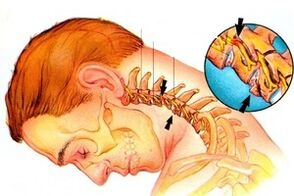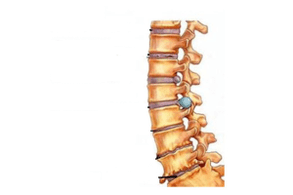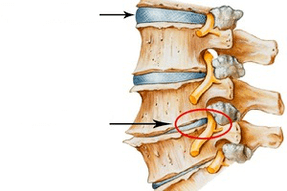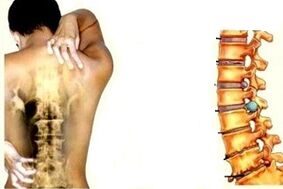
Diseases of the musculoskeletal system are one of the most common diseases on Earth.Few people manage to avoid them completely, especially after 40 years, although experts admit that problems with the spine, muscles and joints have "younger", and very young complaints are increasingly complaining about pain.
The error in this is the lifestyle, which has already become known to many: inactivity, prolonged stays in a position (most often behind gadgets and screens), lack of physical activity.As a result, attitude, salts and other harmful substances are disturbed in the body, the functions of the musculoskeletal system are reduced and as a result internal organs can be deformed.
Most often, osteocondrosis is found of such diseases that humans are subject to both older and fairly young age, and among the osteochondrosis problems with the lumbosacral and cervical spine.The second most frequency type of osteocondrosis, cervical, is an unpleasant disease, and in addition - progressive, without treatment, a markedly deteriorated lifestyle up to disability.This means that it is necessary to recognize the symptoms of this disease in a timely manner and over time contact an orthopedia or a vertebrate for treatment.
How cervical osteocondrosis develops
If a person leads a sedentary lifestyle or by virtue of his profession is in the same position for a long time, the risk of meeting osteocondrosis is very high.With the development of the disease, changes in intervertebral discs occur, they are propagated and change their structure.
Intervertebral discs are placed between the vertebrae, their task is to maintain the spine, to make it flexible and durable.There are seven vertebrae in the neck, using which head is supported and turned, the neck and so on bend.The cervical vertebrae are placed very close to each other so that they are injured and changed even from less physical exertion.The danger of the disease lies in the fact that the nerve endings of the spinal cord nerves are affected because the vessels that supply the brain of the brain are affected.In contrast, the brain does not receive important substances, and this can lead to the development of a number of other, more serious illnesses that can cause the patient's disability and even death.
There are many causes and development of cervical osteocondrosis.Among the most common and frequent reasons the following can be distinguished:

- Decreased reduced metabolism in the body in the cervical region, hormonal imbalance;
- salt deposits;
- Low physical activity, sedentary lifestyle;
- long stay in a position (on the computer, the steering wheel of the car and so on);
- Incorrect nutrition;
- Excess weight;
- damage and marks in the neck;
- Hypothermia in the body.
Osteocondrosis also occurs on the basis of chronic diseases of the musculoskeletal system, such as scoliosis or arthritis.
In addition, an osteocondrosis often carries a genetic disposal of the body.
But whatever the causes, osteocondrosis should be treated as soon as its first symptoms appeared.
Signs of cervical osteocondrosis
Osteocondrosis in this spine does not always occur strongly and unexpectedly.Most often, it develops slowly and the symptoms intensify over time, their number increases.The more the vertebrae are damaged and the nerve roots are damaged, the more noticeable the signs.
The first symptom to be paid is the pain of different strength in the cervix ridge that gives other parts of the body - the back of the head, forehead, ears, forearm, shoulder, chest and so on.In case of pain, consult a doctor to determine if it is really osteocondrosis, which often resembles symptoms with other diseases.
Other signs of osteocondrosis
- The pain in the neck is improved by loads or turning the head;
- The patient feels numbness, burning or tingling in the limbs;
- Headaches and dizziness, a collapse, the patient can complain about darker and fly in the eyes, noise in the ears;
- With a sharp turn of the head, fainting is probably.
Osteochondrosis is also characteristic of cervical osteochondrosis:
- Violation of coordination;
- pain in the heart;
- Deterioration of vision and hearing.
Varieties of osteocondrosis
Depending on the type of clamping of the nerve and nature of the development of the disease, doctors separate several syndromes:
- Rack Syndrome;
- vertebral arteris syndrome;
- Cardial Syndrome.
The root syndrome is a clamp of the first few cervical nerve endings.The pain is felt in the neck, they are given to a shoulder blade, the crucifix, the shoulder, the forearm.
With the syndrome of the spine, the patient experiences a pulsating pain at the back of the head or temples or burning pain in the neck, the back of the head that improves head, during sleep, with cough, gives it to the chest, shoulder.
With heart -syndrome, the symptoms are similar to angina pectoris first, but the pain does not go after taking nitroglycerin, lasts for several hours and can be intensified when moving and deep breathing.
Symptoms of damage to specific vertebrae
Treatment of osteochondrosis is prescribed based on which nerveing was damaged.There are only eight of them, each of them is over the cervical vertebra.It is possible to determine which of the vertebrae are affected by symptoms corresponding to a particular nervous spine.
Damage to nervous ending and characteristic pain

- The first and second departments: the sensitivity of the back of the head, pain in the parietal and the occipital region is broken;
- The third department: numbness in the neck of squeezing, speech inhibition, the sensitivity of the language;It happens very rarely;
- The fourth department: Pain and numbness in the collar and/or shoulder, violations of the respiratory system, heart pain;
- Fifth section: Shoulder pain, pain in the outer surface of the shoulder, decreased sensitivity of the limbs;
- The sixth and seventh departments: pain in the neck, blade, forearm, back, lower back, decreased sensitivity of the hands, fingers;The most frequent defeat;
- The eighth section: pain in the neck, back, elbow, numbness of the small fingers of all limbs, bluest in the legs and brushes due to blood circulation disorders, the lack of skin sensitivity and gives it to the legs.
Diagnosis and treatment of cervical osteocondrosis

To reliably establish the diagnosis of "cervical osteocondrosis", you should definitely consult a doctor.Many symptoms of osteochondrosis are similar to signs of other diseases, so it is important not only in time to begin the treatment of osteochondrosis, but not to miss another pathology.
In case of suspected osteocondrosis and signs of clamping the nerve endings, the doctor prescribes radiography with data error-competed or magnetic resonance tomography, ultrasound additional dopplerography and duplex scanning.
Based on these studies, the nature of the pain syndrome and the whole of other symptoms, you can determine which disks are damaged and begin the necessary treatment that will restore affected vertebrae and nerve roots and not allow complications of osteochondrosis to develop.
The treatment is prescribed by the doctor, it is usually complex.First of all, it must relieve pain symptoms that, with cervical osteocondrosis, are sometimes practically unbearable and spread not only to the neck but also to other parts of the body.
To do this, use painkillers in tablets, but in the case of too severe pain, not -steroidal anti -inflammatory drugs as well as heating and painkillers are.
Since medications and ointments only relieve pain and other symptoms of neck osteochondrosis but do not get rid of its cause.After the painful sensations are reduced, the patient is prescribed massage, physiotherapy and physiotherapy.The patient shows a diet, drugs that improve blood circulation and support the body functions, in tablets and injections as well as chondroprotectors that help protect and restore substances of the intervertebral disks.
In some cases, baths, paraffin applications, reflexology, hirudotherapy are prescribed as further treatment of the patient.Folk methods for treating cervical osteocondrosis often also quickly help returning the patient to the usual lifestyle, but they should only be used in combination with traditional methods and after hearing a doctor, as traditional medicine can have contraindications and the use of its prescription can damage the body so weakened by the body.
Complications and prevention of the disease

Don't forget: Treatment of cervical osteocondrosis should be started as soon as possible.The longer you pull on a visit to the doctor, the more difficult it will be to cure the disease and in the meantime it can cause different complications.Osteocondrosis of cervical spine is very dangerous, as in this section there are many blood vessels and nervous plexuses that feed the brain.
Any violation can cause brain circulation problems, neurological disorders, including migraines and hypertension, affect the heart, respiratory system, consultation, vision.
If osteocondrosis is launched, more serious consequences are possible in the form of brain ischemia, spinal cords or radiculopathy - a disease in which processes are formed on the vertebrae, partly or completely deprive the body of sensitivity and mobility.But this is not the worst as the spinal cord is compressed into severe osteocondrosis, which can cause the patient's death.
Therefore, it is very important to listen to the symptoms as soon as possible and turn to a specialist who helps you return to a full life.And to avoid such a disease as cervical osteocondrosis, you need to move more, not avoid physical activity, monitor the weight, eat properly and in a balanced and also regularly visit an orthopedic or vertebrate.



























